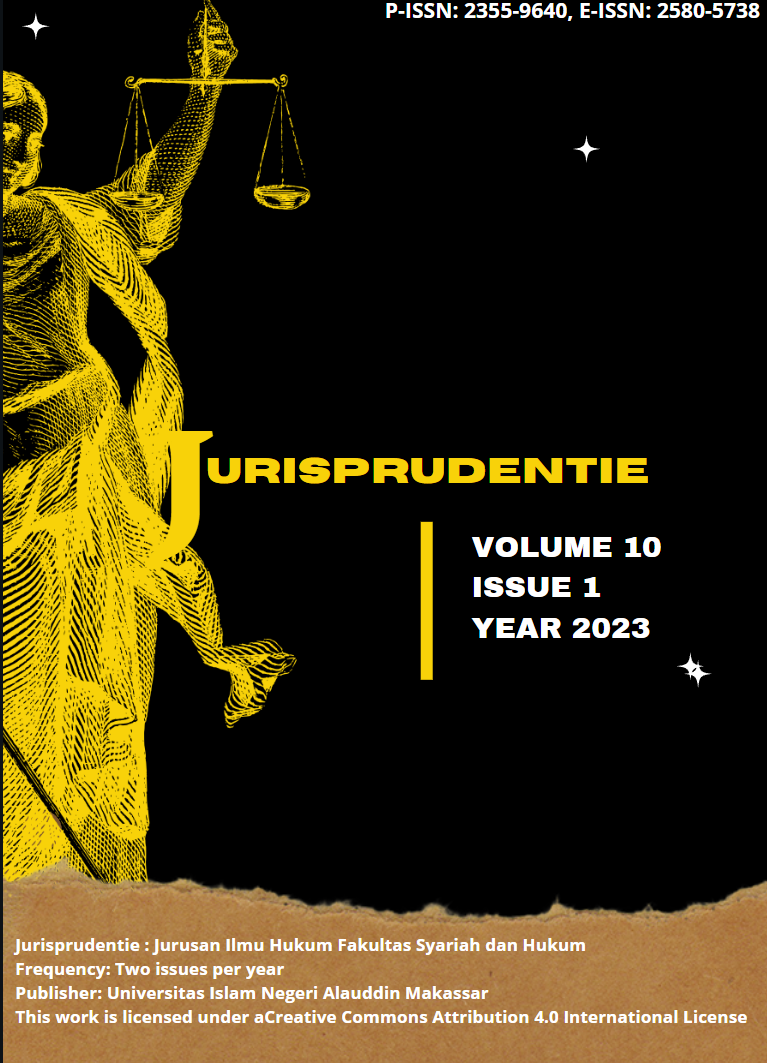Criminological Phenomenon of Illegal Placement of Indonesian Migrant Workers in Sanggau Regency
Abstract
This article seeks to analyze the phenomenon of crimes against Indonesian Workers and Migrants as one of the contributions to the State in protecting its citizens. Looking at real-life conditions, it is known that crimes against workers and migrants have occurred in Indonesia, including the Sanggau Regency. The occurrence of this crime is inseparable from the use by perpetrators to benefit from the ignorance of victims, which is contrary to their dignity and human rights. The condition of victims who are pressed for economic needs also contributes to a reciprocal relationship between perpetrators and victims to be involved in Indonesian Illegal Migrant Workers and results in criminal acts of protection of labor and migrant workers. This study aims to determine the factors of the occurrence of illegal placement of Indonesian migrant workers based on criminological analysis. The method used is field research, explanatory with qualitative data collection using interviews, observations, and legal opinions that are processed descriptively with qualitative analysis. The results show the occurrence of illegal placement of Indonesian migrant workers due to weaknesses in juridical aspects that tend to be convoluted and require costs and the pragmatic thinking of victims.
References
Abdul Munir, M.Krim & Riki Harianto. “REALITAS PENYIMPANGAN SOSIAL DALAM KONTEKS CYBER SEXUAL HARRASMENT PADA JEJARING SOSIAL LIVE STREAMING BIGO LIVE Abdul Munir, M.Krim & Riki Harianto,S.Sos,” 2005, 21–39.
Ariati, Fardillah. “Korupsi Dalam Perspektif Routine Activities Theory” 6, no. 2 (2010): 150.
Easterlin, Richard A. Internal Migration in Developing Countries : A Survey. Vol. I, 1980.
Farhan, Akhmad. “Perbandingan Daya Saing Indonesia Diantara Negara-Negara ASEAN.” Lomba Karya Tulis Ilmiah Persatuan Pelajar Indonesia Malaysia, no. November 2015 (2016): 1.
Hidayat, Hidayat. “Perlindungan Hak Tenaga Kerja Indonesia Di Taiwan Dan Malaysia Dalam Perspektif Hak Asasi Manusia.” Jurnal HAM 8, no. 2 (2017): 105. https://doi.org/10.30641/ham.2017.8.272.
Hidayati, Inayah. “The Process of Migration and Communication Technology Roles among Labor Migrants in Batam - Indonesia” 7, no. 2 (2019): 173–84.
Hukum, Penegakan, Terhadap Perusahaan, Penempatan Pekerja, and Migran Indonesia Ilegal. “Jurist-Diction” 2, no. 5 (2019): 1593–1610.
Ismail, and M. Ridwan Said Ahmad. “Perilaku Anomie Siswa Di Sma Negeri 9 Makassar.” Jurnal Sosialisasi Pendidikan Sosiologi 5, no. 3 (2018): 59–64. https://ojs.unm.ac.id/sosialisasi/article/view/12379.
Lavinia, N. “Mengurangi Peluang Kejahatan Terorisme Terhadap Kepolisian Dengan Pendekatan Situational Crime Prevention (SCP).” Jurnal Lemhannas RI 9, no. 3 (2021). http://jurnal.lemhannas.go.id/index.php/jkl/article/download/241/143.
Lay, Fadilah, Fatimah Ely, Popi Tuhulele, Dyah Ridhul, and Airin Daties. “Pengaturan Tentang Pekerja Migran Dan Tanggung Jawab Negara.” Jurnal Ekonomi 2, no. 2 (2022): 122–29.
Meiyani, Neni. “Penerapan Aliran Filsafat Pragmatisme.” Jassi 12, no. 2 (2013): 209–20. https://ejournal.upi.edu/index.php/jassi/article/download/4066/2929.
Moshinsky, Marcos. “No Titleیلیب.” Nucl. Phys. 13, no. 1 (1959): 104–16.
Muazaroh, Siti, and Subaidi. “Dalam Pemikiran Abraham Maslow.” Al-Mahazib 7, no. 1 (2019): 17–33.
Mudzalifah, Milla, and Puti Priyana. “Implikasi Regulasi Tindak Pidana Illegal Logging Terhadap Kelestarian Lingkungan Hidup Ditinjau Dalam Perspektif Hukum Lingkungan.” Ajudikasi : Jurnal Ilmu Hukum 4, no. 2 (2021): 141–54. https://doi.org/10.30656/ajudikasi.v4i2.2748.
Nola, Luthvi Febrtka. “Upaya Pelindungan Hukum Secara Terpadu Bagi Tenaga Kerja Indonesia (Tki).” Negara Hukum 7, no. 1 (2016): 40. https://jurnal.dpr.go.id/index.php/hukum/article/view/949.
Pangestutiani, Yuni, and Aina Noor Habibah. “Pragmatisme John Deweydan Korelasinya Terhadap Ajaran Islam.” Spiritualis: Jurnal Pemikiran Islam Dan Tasawuf 8, no. 1 (2022): 112–16.
Puanandini, Dewi Asri. “PENEGAKAN HUKUM TINDAK PIDANA PERDAGANGAN ORANG PEKERJA MIGRAN INDONESIA,” n.d. https://doi.org/10.22225/wedj.2.2.1297.44-50.
Ratihtiari, A. A. Titah, and I Wayan Parsa. “Perlindungan Hukum Terhadap Pekerja Migran Indonesia Di Luar Negeri.” Kertha Semaya : Journal Ilmu Hukum 7, no. 7 (2019): 1. https://doi.org/10.24843/km.2019.v07.i07.p02.
Rizki, Faizal Muhamad, and Muhammad Zaky. “Analisis Kriminologis Korban Cyber Fraud Pada Transaksi Game Online Melalui Steam.” Anomie 1, no. 1 (2019): 1–19.
Rosalina, Henny Natasha, and Lazarus Tri Setyawanta. “Perlindungan Hukum Terhadap Pekerja Migran Sektor Informal Dalam Perspektif Teori Bekerjanya Hukum Di Masyarakat.” Jurnal Pembangunan Hukum Indonesia 2, no. 2 (2020): 174–87. https://doi.org/10.14710/jphi.v2i2.174-187.
Suradji. “Penanganan Pekerja Migran Di Malaysia.” Jurnal Ilmu Akuntansi, 2006, 224–34. http://jia.stialanbandung.ac.id/index.php/jia/article/download/425/397.
Syahra, Rusydi. “Anomie Di Tengah Perubahan Sosial.” Masyarakat Dan Budaya 3, no. 1 (2000): 1–19.
Syamsiah, Nur, Institut Agama, Islam Sultan, and Muhammad Syafiuddin Sambas. “Permasalahan Pekerja Migran Indonesia Pada Kawasan Perbatasan Indonesia-Malaysia Di Kabupaten Sambas Kalimantan Barat.” Jurnal Kajian Perbatasan Antarnegara, Diplomasi, Dan Hubungan Internasional 3, no. 2 (2020): 84–95.
Wasitohadi, Wasitohadi. “Pragmatisme, Humanisme Dan Implikasinya Bagi Dunia Pendidikan Di Indonesia.” Satya Widya 28, no. 2 (2012): 175. https://doi.org/10.24246/j.sw.2012.v28.i2.p175-190.
Wau, Citra Metasora, Marihot Janpieter Hutajulu, and Sri Harini Dwiyatmi. “Implikasi Positivisme Hukum Terkait Pengaturan Teknologi Finansial Di Indonesia.” Jurnal Ilmu Hukum: ALETHEA 3, no. 2 (2020): 77–98. https://doi.org/10.24246/alethea.vol3.no2.p77-98.
Once an article was published in the journal, the author(s) are:
- to retain copyright and grant to the journal right licensed under Creative Commons License Attribution that allows others to share the work with an acknowledgement of the work's authorship.
- permitted to publish their work online in third parties as it can lead wider dissemination of the work, with an acknowledgement of its initial publication in this journal
- continue to be the copyright owner and allow the journal to publish the article with the CC BY license
- receiving a DOI (Digital Object Identifier) of the work.


